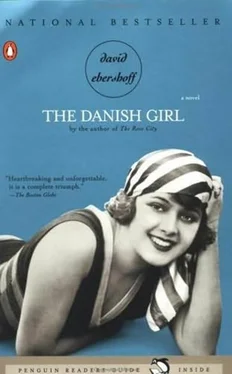When he returned to the clinic the next day, Professor Bolk was unable to see him. “He will call you,” said Frau Krebs, in the same gray skirt. When he heard this, Einar, on the clinic’s portico beneath the lantern lamp, began to cry. The day was no warmer than the previous night, and he began to shiver as he heard the gravel of the driveway crunch beneath his feet. He had no other business to attend to, so he wandered around the city, both hungry and nauseous.
Altmarkt and its stores were busy in the wind, the aisle of the Hermann Roche pharmacy filled with bank clerks on their lunch hour. The buildings were covered with soot that was darker than the sky, and the awnings were painted with the names of the stores whose bronze-case cash registers were sitting more and more idle with each passing month of recession: CARL SCHNEIDER, MARIEN APOTHEKE, SEIDENHAUS, RENNER KAUFHAUS, and HERMANN ROCHE DROGERIE. Motorcars were parked in the center of the square, and there were two boys in tweed hats and knickers, their shins blue and chapped, parking the cars. A woman with her curls pinned up climbed out of her half-door sedan; she was crammed into a blue stretch dress, the wedge of her stomach testing the strength of the threads holding the buttons to her blouse. The two boys steered her car into a narrow space, and then they began to laugh and waddle, mocking the woman, who was applying lipstick obliviously.
The smaller boy looked up and saw Einar and laughed again. The boys looked like brothers, with sharp-tipped noses and cruel matching laughs. Einar realized the boys were no longer laughing at the fat woman, who was picking her way through the traffic and over the tram tracks to make her way into Hermann Roche, which was having a half-price sale on Odol mouthwash and Schuppen pomade. They were laughing at Einar, whose face was hollow and whose topcoat was flapping against the poles of his legs. Einar watched the fat woman through the plate-glass window fingering the cans of Odol. He wished he could be her, examining the prices on the pyramid of cans, tossing a tin of Schuppen into her basket. Einar imagined the woman driving her sedan home to Loschwitz and placing the toiletries in the cabinet above her husband’s sink.
He continued to walk around the city looking in shop windows. A milliner was having a sale, and there was a line of women out the door. A grocer was setting out a crate of cabbage. And Einar stopped at the window of a kite shop. Inside, a man with glasses on the tip of his nose was bending wood rods at a workbench. All around him were different types of kites. A kite like a butterfly, like a pinwheel. Dragon kites and ones with foil in their wings like flying fish. There was an eagle kite, and a small black kite with bulging yellow eyes like a bat’s.
Einar went to the box office of the Semperoper and bought a ticket to Fidelio . He knew that homosexuals gathered at the opera, and he feared that the woman behind the glass, which was smudged with breath, might think he was one of them. She was young and pretty, with green eyes, and refused to look at Einar, cautiously pulling his money through the bowled slot in the window as if she wasn’t sure whether or not she wanted it. And once again Einar became exhausted by the world failing to know who he was.
And then Einar climbed the forty-one steps of the Brühlsche Terrace, which overlooked the Elbe and the right bank. The terrace was planted with square-cut trees and bordered by an iron rail against which strollers leaned to examine the endless arc of the Elbe. The wind was running with the river, and Einar turned up his collar. A man with a cart was selling bratwurst in a bun and little glasses of wine. He handed Einar his food and then poured the apple wine. Einar balanced the wine on his knee as he took a bite of the steaming bratwurst, its skin tight and crisp on the end. Then he took a sip of wine and closed his eyes. “You know what they call this?” the peddler said.
“What?”
“The Brühlsche Terrace. You know they call it the balcony of Europe.” The man smiled, a few teeth missing. He was waiting for Einar to finish the wine so he could take back the glass. The terrace looked out across the river to the concave towers of the Japanese Palace and beyond that to the ox-eyed roofs of Neustadt and the villas with their well-wooded gardens and then to all of open-fielded Saxony. From the terrace, it seemed as if the rest of the world lay beneath Einar, waiting.
“How much do I owe you?” Einar asked.
“Fifty pfennig.” The river was gray and choppy, and Einar handed the man the aluminum-bronze coin.
He finished his wine and returned the glass to the peddler, who wiped it clean with the tail of his shirt. “Good luck to you then, sir,” the peddler called, pushing his cart. Einar watched him, the yellow-stone facades and green-copper roofs of Dresden behind him, the great rococo buildings that made it one of the most beautiful cities Einar had ever seen-the Albertinum, the domed Frauenkirche, the Grünes Gewölbe, the elegant plaza in front of the opera house-a handsome backdrop to the little man and his bratwurst cart. Above the city, the sky was pewter and hammered with storm. Einar was cold and tired, and, standing to leave the Brühlsche Terrace, he nearly felt his past shift beneath him.
Two more days passed before Professor Bolk sent word he could meet with Einar, who returned to the Municipal Women’s Clinic on a bright morning, the street curbs wet and shining. In daylight the clinic looked larger, a cream-colored villa with evenly arched windows and a clock in the eaves. It was set in a small park of oak and birch and willow trees and holly bushes.
Frau Krebs admitted him, escorting him down a hall with a mahogany floor black and dull with wax. The hall was lined with doors, and Einar lifted his eyes and felt embarrassed by his curiosity as he looked into each room. On one side of the hall each room was filled with a panel of sunlight, and there were twin beds by the windows, their eiderdowns plumped like sacks of flour.
“The girls are in the Wintergarten right now,” Frau Krebs was saying. On the nape of her neck, just beneath her hairline, was a birthmark that looked like the ghost of spilled raspberry jam.
The clinic had thirty-six beds, reported Frau Krebs, one pace ahead of Einar. Upstairs were the departments of surgery, internal medicine, and gynecology. Across a courtyard, she pointed out, was a building with a sign above the door that said PATHOLOGY.
“The pathology building is our latest addition,” Frau Krebs said proudly. “It’s where Professor Bolk keeps his laboratory.” The building was square and built from yellow stucco that made Einar think-and he felt ashamed for doing so-of Greta’s chicken-pox scar.
Einar’s first meeting with Professor Bolk was brief. “I’ve met your wife,” he began.
Einar, who was hot beneath his suit and the starched butterfly-collar shirt that was grabbing at his throat, settled onto the examination table. Frau Krebs entered the room, her black shoes squeaking, and handed the professor a file. He was wearing gold-wire glasses that reflected the overhead light and hid the color of his eyes. He was tall and younger than Einar expected, handsome in the jaw. Einar understood why Greta liked him: he had hands so quick, and an Adam’s apple so light, that when he spoke Einar became almost hypnotized by his birdlike hands moving through the air, landing on the corner of his desk where three wood boxes organized his papers, or by the point of his Adam’s apple punctuating his sentences like the persistent beak of a woodpecker.
Professor Bolk requested Einar to strip and stand on the scale. The stethoscope pressed coldly against his chest. “I understand you’re a painter,” Professor Bolk said, but continued, “You’re awfully thin, Mr. Wegener.”
Читать дальше












